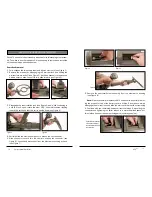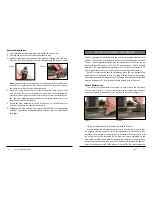
28
Garrett Metal Detectors
ATX
™
29
sufficiently eliminated� This method, although effective, can significantly
reduce the detection of fine gold, jewelry, and other poor conductors due to
the increased Discrimination setting�
Therefore, to help reduce this undesirable loss of detection, the
ATX
has an alternative method to address saltwater� Specifically, the
ATX
can
automatically ground balance out the saltwater response without the need
to increase Discrimination; thereby maintaining a better response to fine
gold, jewelry, and other poor conductors�
The two methods to address saltwater are:
1) Ground Balance Method:
Leave Discrimination set to minimum
and Ground Balance to the saltwater as would be done for any other
ground� This method will provide the best detection of fine gold, etc�, but
will produce a low-tone response for all targets� It is important to Ground
Balance the detector when it moves to a new region of the beach (i�e� from
wet sand to dry sand at the water's edge)�
2) Traditional Discrimination Method:
Incrementally increase the
Discrimination setting until the saltwater response is sufficiently eliminated,
typically around 3–7� Ground Balance is not required with this method� This
method will maintain normal high and low tone responses, but will have
reduced detection of fine gold, etc� Reduce the Discrimination setting
toward zero when moving from wet sand to dry�
For either method, the following basic techniques will help to achieve the
best performance�
1� Swing the searchcoil flat and at a constant height� Do not bounce the
coil or lift the coil at the end of swings�
2� Hunt the three different regions of the beach (dry sand, wet sand,
submerged) one at a time rather than going back and forth between
regions� This will allow the detector to be set optimally for each region�
3� Swing the searchcoil parallel to the water's edge to minimize changes
in moisture levels within a given swing�
The detector may become less stable in shallow, breaking surf where
the searchcoil is in and out of the saltwater� In this area the detector is
encountering a constantly changing environment produced by the surf,
making it more difficult for the detector to stabilize� Experiment with the
two methods above to determine which you prefer, and if necessary, reduce
Sensitivity to obtain stable operation�
The
ATX
can be submerged in water to a 10-foot depth (maximum) to
search in and along shorelines, rivers, piers, docks or swimming holes�
Use of the
ATX
at depths exceeding 10 feet can cause leaks and damage
the detector� Use of the
ATX
beyond the recommended depth will void the
manufacturer's warranty�
The
ATX
is shipped with land-use headphones that include a waterproof
connector and cable; do not, however, submerge the headset� Fully
submersible headphones are available from Garrett as an optional
accessory� For water hunting, use an open coil cover or no coil cover, as the
optional closed coil cover can create excessive drag in the water�
After using the
ATX
in any body of water, it is very important to properly
rinse the detector with fresh water before collapsing the stems� Saltwater
and even freshwater sediment deposits can inhibit the easy operation of
the
ATX
nuts and stems�
(See p. 34 for care and maintenance tips.)
Saltwater Operation
When mixed with water, salt and other electrolytes become conductive and
may therefore cause any detector to respond as if the saltwater were a
metal target� In fact, to a detector, saltwater has an electrical conductivity
very similar to foil, fine gold and other poor conductors�
Traditionally with pulse detectors, to address the saltwater response the
Delay/Discrimination setting was increased until the saltwater response was
WATER USE
Waterproof
headphones
(sold
separately)
must
be used if the
headset is fully
submerged�








































